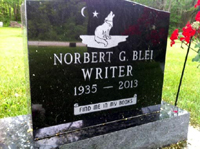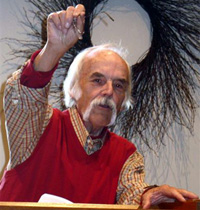
Poetry Dispatch No. 111 | October 17, 2006
In light of October…the bases, the bull pen, the dugout, the batting box, the baseline; pitchers and catchers, outfielders and infielders, balls and strikes, innings (top-half and bottom-half), umpires and coaches, batters and designated hitters; fair balls and foul balls, home runs and shut outs; in light of all the light in all the green fields of dreams at this time of year…Norbert Blei

Analysis of Baseball by May Swenson
It’s about
the ball,
the bat,
and the mitt.
Ball hits
bat, or it
hits mitt.
Bat doesn’t
hit ball, bat
meets it.
Ball bounces
off bat, flies
air, or thuds
ground (dud)
or it
fits mitt.
Bat waits
for ball
to mate.
Ball hates
to take bat’s
bait. Ball
flirts, bat’s
late, don’t
keep the date.
Ball goes in
(thwack) to mitt,
and goes out
(thwack) back
to mitt.
Ball fits
mitt, but
not all
the time.
Sometimes
ball gets hit
(pow) when bat
meets it,
and sails
to a place
where mitt
has to quit
in disgrace.
That’s about
the bases
loaded,
about 40,000
fans exploded.
It’s about
the ball,
the bat,
the mitt,
the bases
and the fans.
It’s done
on a diamond,
and for fun.
It’s about
home, and it’s
about run.
from The Complete Poems to Solve

 May Swenson (b. Anna Thilda May Swenson, May 28, 1913 in Logan, Utah – December 4, 1989 in Bethany Beach, Delaware) was an American poet and playwright.
May Swenson (b. Anna Thilda May Swenson, May 28, 1913 in Logan, Utah – December 4, 1989 in Bethany Beach, Delaware) was an American poet and playwright.
The first child of Margaret and Dan Arthur Swenson, she grew up as the eldest of 10 children in a Mormon household where Swedish was spoken regularly and English was a second language. Much of her later poetry works were devoted to children, although she also translated the work of contemporary Swedish poets, including the collection Iconographs (1970) and the selected poems of Tomas Transtromer.
Swenson attended Utah State University in Logan in the class of 1939, where she received a bachelor’s degree. She taught poetry at several universities, including Bryn Mawr, the University of North Carolina, the University of California at Riverside, Purdue University and Utah State University. From 1959 to 1966 she worked as an editor at New Directions publishers. She also served as a Chancellor of The Academy of American Poets from 1980 until her death in 1989.
Her poems were published in Antaeus, The Atlantic Monthly, Carleton Miscellany, The Nation, The New Yorker, Paris Review, The Saturday Review, Parnassus and Poetry.
She received much recognition for her work. Some of which include:
- * American Introductions Prize in 1955;
- * William Rose Benet Prize of the Poetry Society of America in 1959;
- * Longview Foundation Award in 1959;
- * National Institute of Arts and Letters Award in 1960;
- * Brandeis University Creative Arts Award in 1967;
- * Lucy Martin Donnelly Award of Bryn Mawr College in 1968;
- * Shelley Poetry Award in 1968
- * Guggenheim fellowship in 1959,
- * Amy Lowell Travelling Scholarship in 1960,
- * Ford Foundation grant in 1964
- * Bollingen Prize for poetry in 1984,
- * MacArthur Fellowship in 1987.
Swenson’s work shows strong use of imagery and use of eroticism. She continually questions existence and writes much on the topic of love. Her love poems concerned “human nature, the natural world, geography, and invention. They are poems of intense love between women, written at a time when that genre was rare in poetry” (Schulman.) A self proclaimed lesbian, much critique has been done on her heterosexual imagery. Although she did not go out of her way to make known her sexual identity, she also did not hide it. Perhaps she did promote her sexuality because of the times, religion, or maybe just personal preference not to. In her career she has turned down publication offers to use her poetry in a compilation of lesbian writing, yet she did agree in one case, which she explained as a tasteful collection she did not mind contributing to. Her biography The Love Poems of May Swenson focused mostly on poems in which sexual imagery is especially abundant. It is considered her book of strongest love poems. One example, the poem “In the Yard” reads:
You’re back,
barefoot, brought
some fruit. Split me
an apple. We’ll
get red, white
halves each, our
juice on the
Indian spread. (Nature 94)
Swenson’s style is described as rhythmic. Her creative style merges in her writing with her interest in plant and animal behaviour with works such as “The Cross Spider“. As well as natural themes, some of her work focuses on scientific research, for example the exploration of space. Fascinated by perception, much of Swenson’s work contains key themes of how this human perception can be found in landscapes and wider contexts. One source comments that her use of nature and sexuality are not used separately, but that nature is something we are all part of, and in that commonality we share energy derived from sexuality.
Working with the Literary Estate of May Swenson, Utah State University (USU) has created the “May Swenson Project“. Supported by students and teachers, it has publicized Swenson’s work at USU, as well as her influence across the nation. In her name, USU has dedicated a May Swenson room in the English Department and another in the USU Merrill-Cazier Library. Funds are being sought to establish an endowed chair in Swenson’s name.
The May Swenson Poetry Award, sponsored by Utah State University Press, is a competitive prize granted annually to an outstanding collection of poetry in English. Open to published and unpublished writers, with no limitation on subject, the competition honors May Swenson as one of America’s most vital and provocative poets of the twentieth century. Judges for the competition have included Mary Oliver, Maxine Kumin, John Hollander, Mark Doty, Alice Quinn, Harold Bloom, and others from the first tier of American letters.
Bibliography
Poetry:
- * Another Animal (Scribner, 1954);
- * A Cage of Spines (Rinehart, 1958);
- * To Mix with Time: New and Selected Poems (Scribner, 1963);
- * Poems to Solve (for children “14-up”) (Scribner, 1966);
- * Half Sun Half Sleep (Scribner, 1967);
- * More Poems to Solve (Scribner, 1968);
- * Iconographs (Scribner, 1970);
- * New & Selected Things Taking Place (Little, Brown, 1978);
- * In Other Words (Knopf, 1987).
Prose:
- * The Contemporary Poet as Artist and Critic (1964)
Anthology:
- * Iconographs (1970)
- * Windows and Stones: Selected Poems of Tomas Tranströmer (1972)



























































Leave a comment